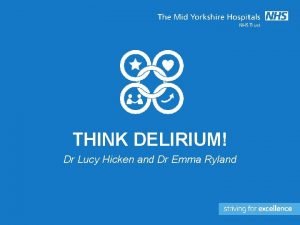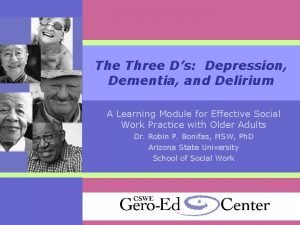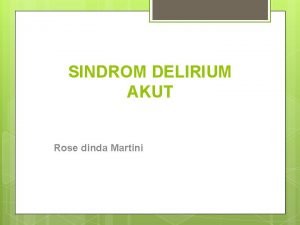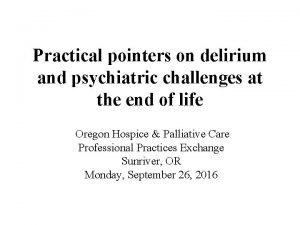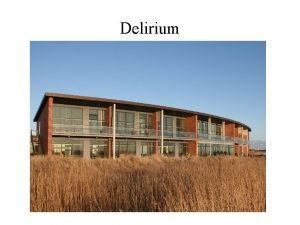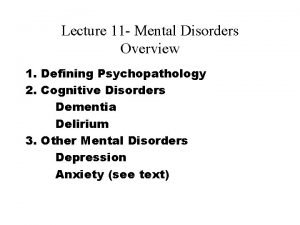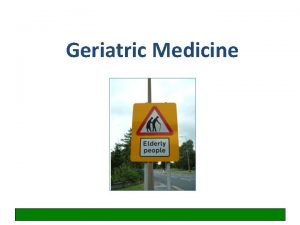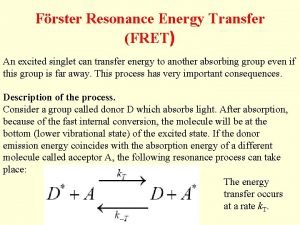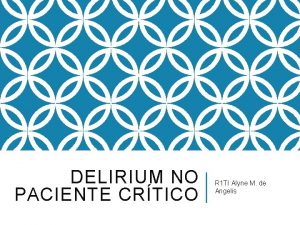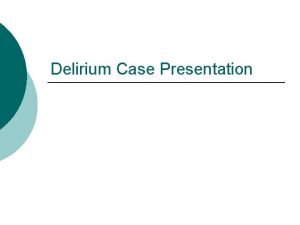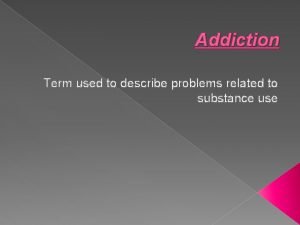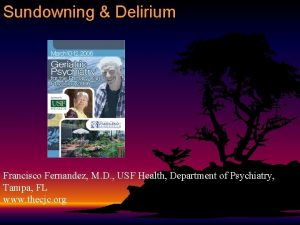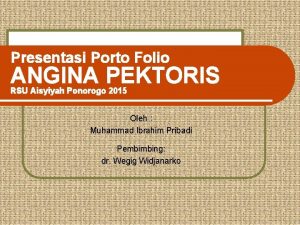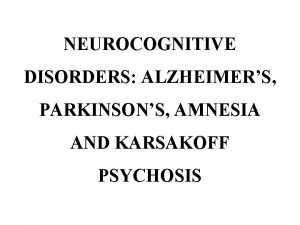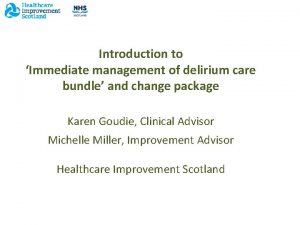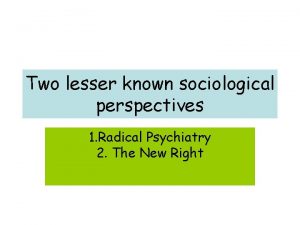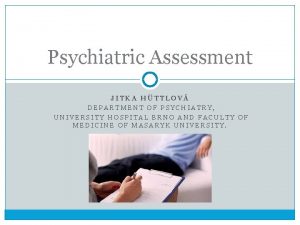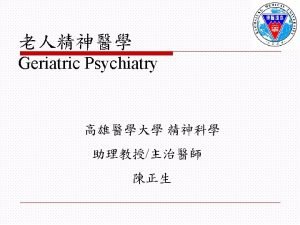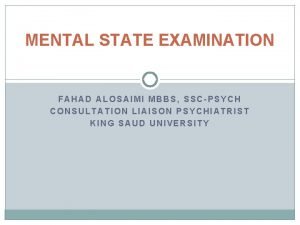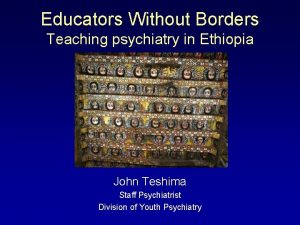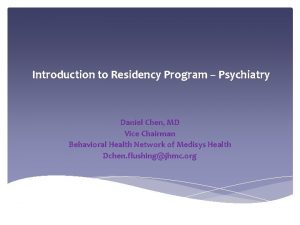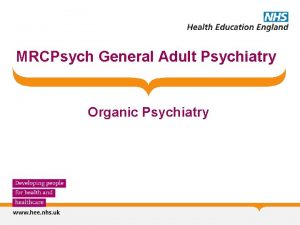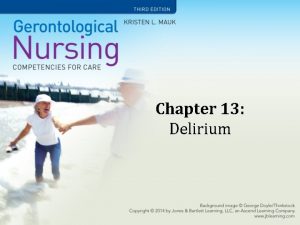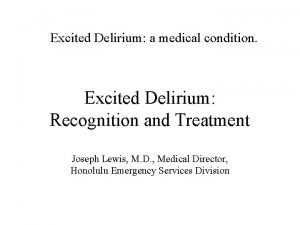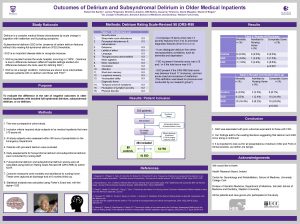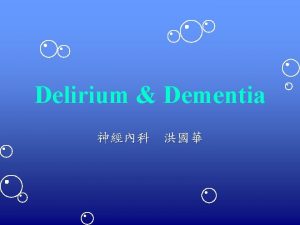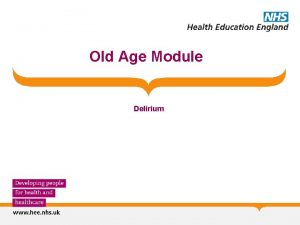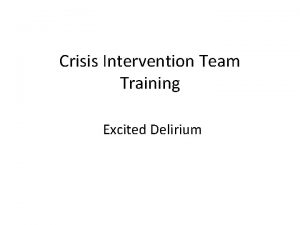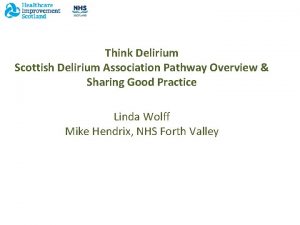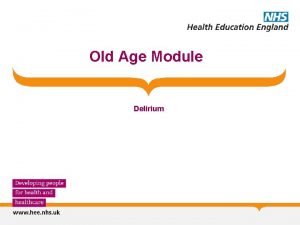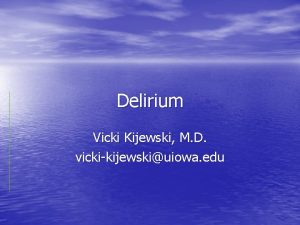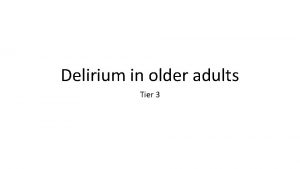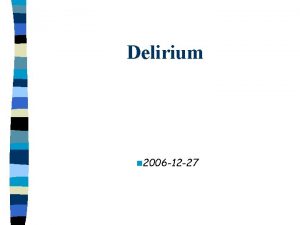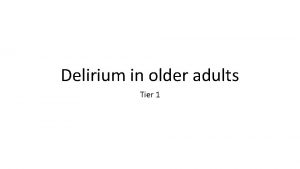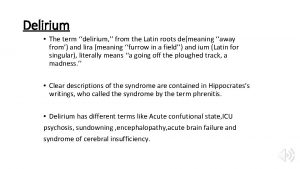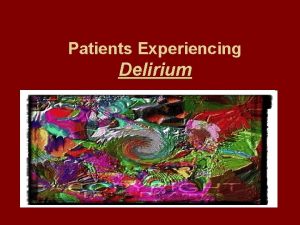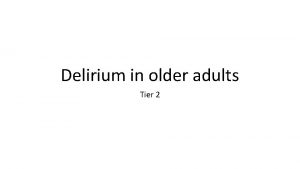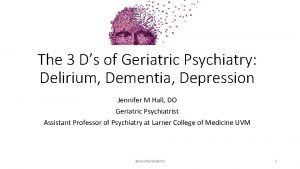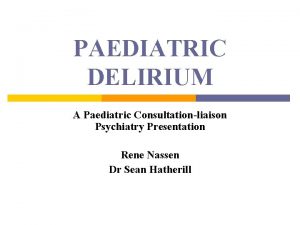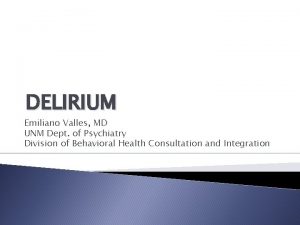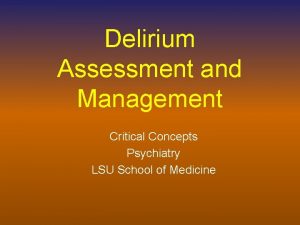PSYCHIATRY PEDIATRICS Chapter I 5 Pediatric Delirium A


























- Slides: 26

PSYCHIATRY & PEDIATRICS Chapter I. 5 Pediatric Delirium: A Practical Approach Jan N M Schieveld, Erwin Ista, Hennie Knoester & Marja L Molag DEPRESSION IN CHILDREN AND ADOLESCENTS Companion Power. Point Presentation Adapted by Julie Chilton

The “IACAPAP Textbook of Child and Adolescent Mental Health” is available at the IACAPAP website http: //iacapap. org/iacapap-textbook-of-child-and-adolescentmental-health Please note that this book and its companion Power. Point are: · Free and no registration is required to read or download it · This is an open-access publication under the Creative Commons Attribution Noncommercial License. According to this, use, distribution and reproduction in any medium are allowed without prior permission provided the original work is properly cited and the use is non-commercial.

Pediatric Delirium Outline • The Basics • Epidemiology • Clinical Characteristics • Etiology • Diagnosis • Treatment • Sequelae

Pediatric Delirium The Basics: “also known as” • • • acute confusional state toxic psychosis ICU psychosis organic psychosyndrome encephalopathy

Pediatric Delirium The Basics: Historical Context • First described in 1935 • Underrecognized and underdescribed until 1991 • Awareness increasing in last few years • More publications lately • More research needed Paul Eugen Bleuler

Pediatric Delirium The Basics: Definition • Latin de-lira (out of the track) • Neurocognitive disorder due to a somatic illness or its treatment • One of several brain reactions to illness: – Sickness behavior – Fever – Epilepsy – Catatonia – Delirium – Refractory agitation – Coma

Pediatric Delirium The Basics: DSM-5 Criteria – Disturbance of attention*/awareness – Changes in cognition – Develops quickly and fluctuates – Typically worse in evening – Likely result of medical condition or treatment – Excludes coma *attention is the first to be lost and the last back

Pediatric Delirium The Basics: ICD-10 Criteria • Etiologically nonspecific organic cerebral syndrome with disturbances of: – – – – Consciousness and attention Perception Thinking Memory Psychomotor behavior Emotion Sleep-wake schedule • Variable duration and severity

Pediatric Delirium • • Epidemiology: Delirium High prevalence 10 -30% of general hospital patients Up to 80% in intensive care In adults, associated with increased: – Length of stay – Morbidity – Mortality • In elderly, associated with: – Faster cognitive decline – Loss of independence – Increased mortality x 1 year • Most important predictor of proximity of death in elderly and oncology patients of any age

Pediatric Delirium Epidemiology: Pediatric Delirium • 20 -30% of critically ill children • A worldwide problem in PICU’s* • Risk factors include: Younger age Severity of underlying illness Number of medications Diagnostic tools used General ward vs intensive care unit – Developmental delay – Previous episode – – – PICU: Pediatric intensive care unit Zbigniew J Lipowski

Pediatric Delirium Clinical Characteristics • Can be benign or non-benign • 2 types of benign delirium: – Emergence delirium/agitation • • Immediate postoperative period After anesthesia withdrawal Short-lived~ 30 -45 minutes Resolves completely – Common/general practice delirium • • • With infections, fevers Confusion Waxing/waning course Worse at night Resolves within 2 -3 days If persistent, or already present in the morning, it requires emergency medical evaluation

Pediatric Delirium Clinical Characteristics: Non-Benign • Hyperactive – Agitation – Irritability – Increased motor activity • Hypoactive: – Apathetic – Uninterested • Mixed

Pediatric Delirium Case Vignette: Hyperactive Delirium • 6 year old boy with asthma attack • Intubated and sedated in ICU • After extubation on day 3: Confused anxious Hallucinations of flying objects and monsters Verbally aggressive Diagnosed with delirium and treated with lorazepam and IV haloperidol – Improved after 24 hours – –

Pediatric Delirium Case Vignette: Hypoactive Delirium • 3 year old girl mechanically ventilated for 6 days after tracheal surgery • Sedated with midazolam, ketamine, dexmedetomidine, levomepromazine, dexamethasone, and morphine • Everything tapered for extubation and morphine switched to methadone • Day after extubation became: – – Agitated and disoriented Unable to focus attention Then apathetic and unresponsive 21 points on the CAP-D

Pediatric Delirium Etiology: I WATCH DEATH* *MG Wise in Textbook of Neuropsychiatry (1987)

Pediatric Delirium Diagnosis: Important Questions • • Eye contact with parents? Purposeful actions? Aware of surroundings? Restless? Inconsolable? Underactive? Increased response latency? “This is NOW not my child anymore!” (comment by parents, family)


Pediatric Delirium Diagnosis: 3 Questions to Ask after a Positive Score 1. Developing somatic complications? 2. Medication change? 3. Physical discomfort?

Pediatric Delirium Treatment: Non-pharmacological Interventions • Minimize risk factors: – Repeated orientation – Early mobilization – Noise reduction – Non-pharmacologic sleep management – Day-night rhythm – Single room

Pediatric Delirium Pharmacologic Treatment: Hyperactive Delirium • • • Preventive administration not recommended Consider for: – Anxiety, agitation, hallucinations, sleep Monitor drug-drug interactions Weigh risks and benefits Same medications used in adults and children – Benzodiazepine withdrawal benzodiazepines and clonidine – Opiate withdrawal clonidine and methadone Recommendations based on consensus not evidence – IV and PO haloperidol (EKG if risk factors) – PO risperidone – adverse effects: dystonia, oculogyric crisis, akathisia, hyperpyrexia Start low and go slow Scales 3 times a day Wean gradually

Pediatric Delirium Pharmacologic Treatment: Hyperactive Delirium EXAMPLE • Using repeated loading doses (starting low & going slow) try to find a therapeutic response after 1 or 2 hours, or in the first 24 hours, and the duration of it. • Then calculate, based on these data, a maintenance dosage for the next 24 hours (divided in 3 doses). • The maintenance dosages suggested are only indicative.


Pediatric Delirium Pharmacologic Treatment • Preventive administration not recommended

Pediatric Delirium P harmacological Treatment: Hypoactive Delirium • No studies • No consensus

Pediatric Delirium Sequelae of Delirium in Children and Parents • • • No studies on delirium Increased length of hospital stay Large increase in hospital costs Increased mortality PTSD symptoms Delusional memories • Cognitive problems after intensive care unit stays – – Hypoxia Hypoperfusion Infection Trauma • Neurotoxicity in animal studies – Benzodiazepines – Opioids – Anesthetics

Pediatric Delirium T hank You!
 Lucie big delirium
Lucie big delirium Difference between dementia and delirium
Difference between dementia and delirium Dr rose dinda martini
Dr rose dinda martini Nash delirium
Nash delirium Terminalt delirium
Terminalt delirium Escala rass
Escala rass Delirium care pathways
Delirium care pathways Acute confusion related to
Acute confusion related to Delirium definition
Delirium definition Excited delirium перевод
Excited delirium перевод Escala rass
Escala rass Delirium case presentation
Delirium case presentation Flocculation delirium
Flocculation delirium Francisco fernandez md
Francisco fernandez md Kesadaran gcs
Kesadaran gcs Types of amnesia
Types of amnesia Driver diagram palliative care
Driver diagram palliative care Radical psychiatry sociology
Radical psychiatry sociology Assessment skills
Assessment skills Geriatric psychiatry definition
Geriatric psychiatry definition Forensic psychiatry vs forensic psychology
Forensic psychiatry vs forensic psychology Mse appearance
Mse appearance Neurology shelf exam percentiles
Neurology shelf exam percentiles European psychiatry
European psychiatry Psychiatry in ethiopia
Psychiatry in ethiopia Jamaica hospital psychiatry residency
Jamaica hospital psychiatry residency Define yobbish
Define yobbish
